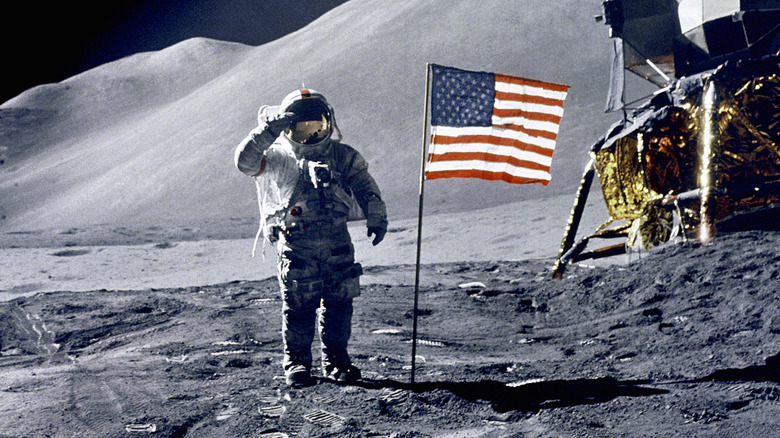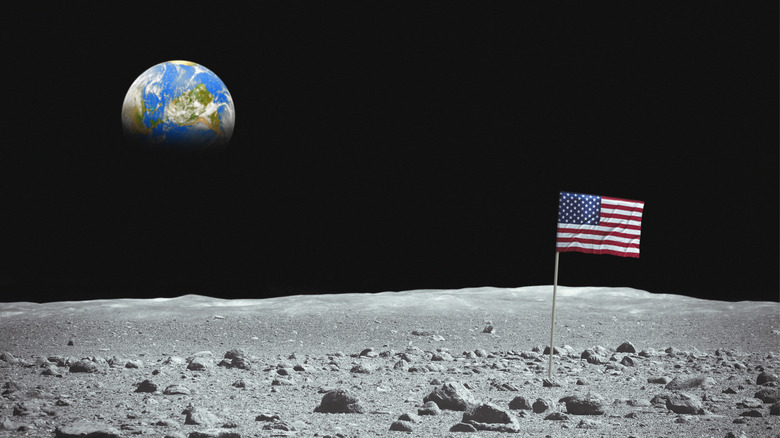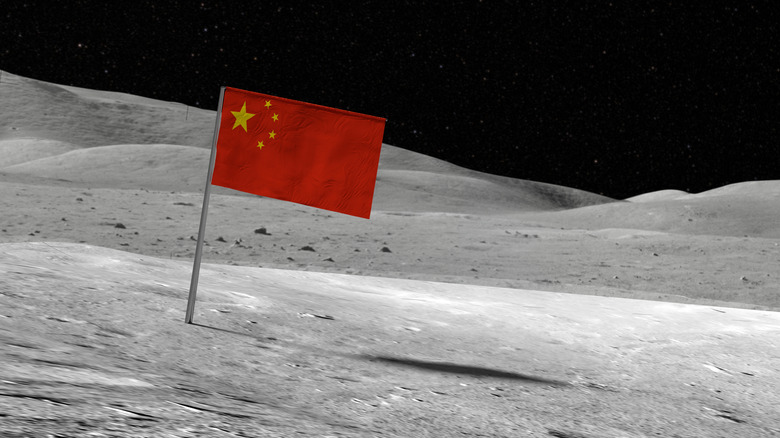Is The American Flag Still On The Moon, And Can You See It With A Telescope?
July 20, 1969, has become one of the most significant dates in the history of the United States as well as humanity at large. Powered by incredibly advanced technology for its day, the Apollo 11 mission saw astronauts Neil Armstrong and Buzz Aldrin land on the moon and set foot on the lunar surface. As part of their expedition, the two planted the American flag on the surface, which has gone on to become an enduring symbol of the National Aeronautics and Space Administration and its greatest achievements. Still, that was a long time ago, well over 50 years ago at the time of writing. So, is the flag still there?
The moon is mysteriously rusting, and there's a solid chance it isn't doing so with the Apollo 11 flag standing upright on its surface. That flag reportedly fell over at some point, with Aldrin and Armstrong's vessel likely knocking it over during their departure decades ago. Lying on the moon's surface, coupled with the Sun's ultraviolet rays hitting it constantly for over half a century, has also likely caused it to almost completely degrade, with the best-case scenario being that it's discolored. All of that is to say that spotting the flag is not likely, even with a remarkably powerful telescope.
Even though the Apollo 11 American flag's time on the moon has likely come to an end, it certainly wasn't the only American flag to grace the moon. Others were planted in subsequent decades, and they've lasted a lot longer than Aldrin and Armstrong's.
Many of the post-Apollo 11 flags have fared much better
NASA has sent astronauts up into space to return to the moon a handful of times since the Apollo 11 mission. On November 19, 1969, Apollo 12 astronauts Pete Conrad and Alan Bean set up the second American flag on the moon, which is still present today. On February 5, 1971, Alan Shepard and Ed Mitchell set up a flag of their own during the Apollo 14 mission. Sadly, it doesn't seem their flag has withstood the test of time. The same is possibly the case for the Apollo 15 flag, which was planted on the moon on July 26, 1971, by astronauts David R. Scott, James B. Irwin, and Alfred M. Worden.
Apollo 16 saw astronauts John Young, Thomas Mattingly II, and Charles Duke reach the lunar surface on April 20, 1972. Keeping with tradition, an American flag was left on the moon during this expedition, and decades later, it's said to still be standing. The final flag to be planted during the Apollo series of missions is also still going strong, too. That one broke ground on the moon on December 11, 1972, thanks to the efforts of Eugene Cernan and Harrison Schmitt. Despite many of the Apollo mission flags remaining upright, seeing them from Earth is just not possible, even with state-of-the-art consumer telescopes.
The United States never passed up an opportunity to plant a flag on the moon. Surprisingly, only one other nation has done so, and on just one occasion.
The US isn't the only nation to place a flag on the moon
Throughout the space race of the late 1950s to the early 1960s and subsequent decades, several countries' space programs have made it to the moon. In a landmark moment, the Soviet Union did so in 1959 — a whole decade before the Apollo 11 mission — while China reached the moon for the first time in 2013. Most recently, India's Chandrayaan-3 spacecraft touched down on the lunar surface on August 23, 2023. At the time of publication, these are the only four nations to reach the moon, and only two have planted flags on the celestial body.
As established, the U.S. has planted many on the moon, which is a feat only China can say it has successfully done as well. The country achieved this historic milestone on December 3, 2020, by way of the Chang'e 5 lunar lander. The flag isn't just a run-of-the-mill one, either, having been specifically designed to handle much of the harshness that comes with prolonged presence on the moon. It can withstand a temperature difference of plus or minus 270 degrees Fahrenheit, so one can only hope that it holds up better than some of the previous flags planted on the moon.
Space travel is one of humanity's greatest accomplishments. Being able to take a symbol of our civilization, like a flag, and erect it so far from our home — albeit to mixed results over time — is truly remarkable. Perhaps someday we'll even manage to step up our game and grow food on the moon.


